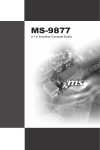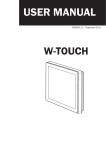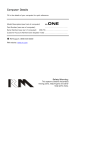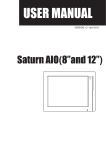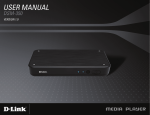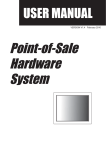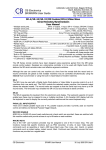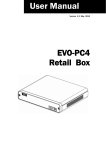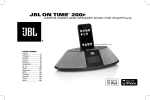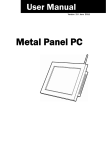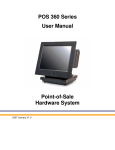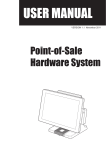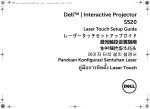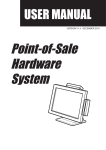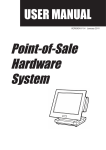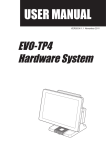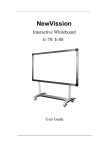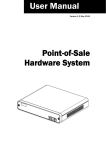Download icon-file-text-o - Support Technique AURES
Transcript
USER MANUAL VERSION 1.3 June 2012 Metal Panel PC Hardware System Copyright 2012 All Rights Reserved Manual Version 1.3 Part Number: 3LMKK7500113 The information contained in this document is subject to change without notice. We make no warranty of any kind with regard to this material, including, but not limited to, the implied warranties of merchantability and fitness for a particular purpose. We shall not be liable for errors contained herein or for incidental or consequential damages in connection with the furnishing, performance, or use of this material. This document contains proprietary information that is protected by copyright. All rights are reserved. No part of this document may be photocopied, reproduced or translated to another language without the prior written consent of the manufacturer. TRADEMARK Intel®, Pentium® and MMX are registered trademarks of Intel® Corporation. Microsoft® and Windows® are registered trademarks of Microsoft Corporation. Other trademarks mentioned herein are the property of their respective owners. Safety IMPORTANT SAFETY INSTRUCTIONS 1. To disconnect the machine from the electrical power supply, turn off the power switch and remove the power cord plug from the wall socket. The wall socket must be easily accessible and in close proximity to the machine. 2. Read these instructions carefully. Save these instructions for future reference. 3. Follow all warnings and instructions marked on the product. 4. Do not use this product near water. 5. Do not place this product on an unstable cart, stand, or table. The product may fall, causing serious damage to the product. 6. Slots and openings in the cabinet and the back or bottom are provided for ventilation to ensure reliable operation of the product and to protect it from overheating. These openings must not be blocked or covered. The openings should never be blocked by placing the product on a bed, sofa, rug, or other similar surface. This product should never be placed near or over a radiator or heat register or in a built-in installation unless proper ventilation is provided. 7. This product should be operated from the type of power indicated on the marking label. If you are not sure of the type of power available, consult your dealer or local power company. 8. Do not allow anything to rest on the power cord. Do not locate this product where persons will walk on the cord. 9. Never push objects of any kind into this product through cabinet slots as they may touch dangerous voltage points or short out parts that could result in a fire or electric shock. Never spill liquid of any kind on the product. ii CE MARK This device complies with the requirements of the EEC directive 2004/108/EC with regard to “Electromagnetic compatibility” and 2006/95/EC “Low Voltage Directive”. FCC This device complies with part 15 of the FCC rules. Operation is subject to the following two conditions: (1) This device may not cause harmful interference. (2) This device must accept any interference received, including interference that may cause undesired operation. CAUTION ON LITHIUM BATTERIES There is a danger of explosion if the battery is replaced incorrectly. Replace only with the same or equivalent type recommended by the manufacturer. Discard used batteries according to the manufacturer’s instructions. Battery Caution Risk of explosion if battery is replaced by an incorrectly type. Dispose of used battery according to the local disposal instructions. Safety Caution Note: To comply with IEC60950-1 Clause 2.5 (limited power sources, L.P.S) related legislation, peripherals shall be 4.7.3.2 “Materials for fire enclosure” compliant. 4.7.3.2 Materials for fire enclosures For MOVABLE EQUIPMENT having a total mass not exceeding 18kg.the material of a FIRE ENCLOSURE, in the thinnest significant wall thickness used, shall be of V-1 CLASS MATERIAL or shall pass the test of Clause A.2. For MOVABLE EQUIPMENT having a total mass exceeding 18kg and for all STATIONARY EQUIPMENT, the material of a FIRE ENCLOSURE, in the thinnest significant wall thickness used, shall be of 5VB CLASS MATERIAL or shall pass the test of Clause A.1 iii LEGISLATION AND WEEE SYMBOL 2002/96/EC Waste Electrical and Electronic Equipment Directive on the treatment, collection, recycling and disposal of electric and electronic devices and their components. The crossed dust bin symbol on the device means that it should not be disposed of with other household wastes at the end of its working life. Instead, the device should be taken to the waste collection centers for activation of the treatment, collection, recycling and disposal procedure. To prevent possible harm to the environment or human health from uncontrolled waste disposal, please separate this from other types of wastes and recycle it responsibly to promote the sustainable reuse of material resources. Household users should contact either the retailer where they purchased this product, or their local government office, for details of where and how they can take this item for environmentally safe recycling. Business users should contact their supplier and check the terms and conditions of the purchase contract. This product should not be mixed with other commercial wastes for disposal. iv Revision History Changes to the original user manual are listed below: Revision Description 1.0 1.1 1.2 1.3 • • • • Initial release IdeaCom touch driver installation added C68 MB added C56 MB added Date April 2011 June 2011 March 2012 June 2012 v Table of Contents 1. Packing List .............................. 1 1-1. Standard Items ........................................................1 1-2. Optional Items .........................................................2 2. System View ............................. 3 2-1. 2-2. 2-3. 2-4. Front & Side View ....................................................3 Rear View ................................................................3 I/O view....................................................................4 Dimensions .............................................................5 2-4-1. 2-4-2. 2-4-3. 2-4-4. 10.1" System ............................................................ 5 15.6" System ............................................................ 6 18.5" System ............................................................ 6 21.5" System ............................................................ 6 3. System Assembly .................... 7 3-1. Open the Chassis Cover .........................................7 3-2. RAM Module Replacement......................................8 3-3. HDD Replacement...................................................9 4. Peripheral Installation ............ 11 4-1. MSR Installation ..................................................... 11 4-2. Stand Installation ....................................................12 4-3. Cash Drawer Installation ........................................13 vi 5. Specification ........................... 15 6. Jumper Setting ........................ 21 6-1. C48 Motherboard....................................................21 6-1-1. Motherboard Layout ................................................ 21 6-1-2. Connectors & Functions ........................................... 23 6-1-3. Jumper & BIOS/Utility Setting ................................. 24 6-2. C68 Motherboard....................................................30 6-2-1. Motherboard Layout ................................................ 30 6-2-2. Connectors & Functions .......................................... 31 6-2-3. Jumper Setting ........................................................ 32 6-3. C56 Motherboard....................................................37 6-3-1. Motherboard Layout ................................................ 37 6-3-2. Connectors & Functions .......................................... 38 6-3-3. Jumper Setting ........................................................ 39 6-4. IdeaCom Touch Driver Installation..........................43 6-4-1. Gesture Setup example for WinXP........................... 47 6-4.2. Gesture Setup example for Win7.............................. 51 Appendix: Drivers Installation .... 55 vii The page is intentionally left blank. viii 1. 1-1. Packing List Standard Items a. b. c. d. e. f. g. a. b. c. d. e. f. g. System Power adapter Driver bank Power cord User manual RJ45-DB9 cable (x2) Allen wrench Note: Power cord will be supplied differently according to various region or country. 1 1-2. Optional Items MSR 2 2. System View 2-1. Front & Side View 2 3 4 1 1. Touch screen 2. Built-in web cam 2-2. 3. Ventilation 4. MSR cable hole Rear View K757 / K758 / K759 K755 5 5 7 6 6 5. VESA mounting holes 6. Cable cover 7. Safety label 3 2-3. I/O view m C48 Motherboard a b c d e Item No. a b c d e f g h i j k l m g f h j i k Description DC IN LAN Cash drawer MIC IN Line out COM port 1, 2, 3, 4 (from left to right) USB(x4) Printer Power button VGA HDD 5V SATA (e-SATA) HDD slot C68 Motherboard a b Item No. a b c d e f g h i j k 4 c d e f g h i Description MIC IN DC IN LAN (x2) Cash drawer Line Out COM port 1, 2, 3, 4 (from left to right) USB(x4) Printer Power button VGA HDD slot j k l C56 Motherboard a b Item No. a b c d e f g h i d e f g h i Description 2nd power button Power button DC IN VGA) COM port 1, 2, 3, 4 (from left to right) LAN USBx4 (two optional USB) Cash drawer USB(x2) Dimensions 2-4-1. 10.1" System 263mm 170mm 2-4. c 38mm 5 2-4-2. 15.6" System 245mm 396mm 48mm 2-4-3. 18.5" System 284mm 464mm 48mm 2-4-4. 21.5" System 328mm 536mm 48mm 6 3. System Assembly 3-1. Open the Chassis Cover The motherboard and RAM module can be replaced by opening the chassis cover, which is located on the back side of the system. Please follow the steps below to open the chassis cover. 1. Turn to the back side of the system and loosen the thumb screws (x2) to release the cable cover first. 2. Loosen the hex socket cap screws (x8) to open the back cover of the system. * An allen wrench is included in the package for simple assembly. Please use it to tighten/loosen the screws. 7 3-2. RAM Module Replacement To remove and replace the RAM module, please open the chassis cover firstly as steps dscribed in chapter 3-1. Removing a RAM module 1. Find the memory slot at the right side of the motherboard. C48 Motherboard C68 Motherboard C56 Motherboard 2. Flip the ejector clips outwards to remove the memory module from the memory slot. 8 Installing a RAM moudle 3. Slide the memory module into the memory slot and press down until the ejector clips snaps in place. 3-3. HDD Replacement To remove and replace the HDD, please open the cable cover firstly as stpes dscribed in chapter 3-1-1. K757 / K758 / K759 1. Find the HDD located at the right side. 2. Pull the HDD tray from the system. For easier removal pull the plastic sheet (see picture) at the same time. 9 3. Attach the HDD to the HDD tray and slide it into the slot until it snaps in place. * Please note the top of the HDD should be on the upper side. K755 1. Loosen the screws(x2) to remove the HDD bracket from the system. 2. The HDD is secured by the bracket, remove the screws(x2) to release the bracket and replace the HDD. 10 4. 4-1. Peripheral Installation MSR Installation To install MSR, please open the cable cover firstly as steps described in chapter 3-1-1. 1. Insert MSR module in place and fasten the screws (x2) on the back to secure the module. 2. Connect MSR cable to the connector on system side. 2. Close the cable cover and fasten screws (x2). Make sure the MSR cable is threaded through the MSR cable hole on the system. 11 4-2. Stand Installation 1. Place the system face down. Make sure not to scrath the screen. 2. Attach the stand to the back of the system. 3. Fasten the screws(x4) to secure the stand. 12 4-3. Cash Drawer Installation You can install a cash drawer through the cash drawer port. Please verify the pin assignment before installation. Cash Drawer Pin Assignment 6 Pin 1 2 3 4 5 6 1 Signal GND DOUT bit0 DIN bit0 12V / 19V DOUT bit1 GND Cash Drawer Controller Register The Cash Drawer Controller use one I/O addresses to control the Cash Drawer. Register Location: 48Ch Attribute: Read / Write Size: 8bit BIT BIT7 Attribute Reserved BIT6 Read BIT5 BIT4 Reserved BIT3 BIT2 Write BIT1 BIT0 Reserved 7 6 5 4 3 2 1 0 X X X X X Reserved Cash Drawer “DOUT bit0” pin output control Cash Drawer “DOUT bit1” pin output control Reserved Cash Drawer “DIN bit0” pin input status Reserved 13 Bit 7: Reserved Bit 6: Cash Drawer “DIN bit0” pin input status. = 1: the Cash Drawer closed or no Cash Drawer = 0: the Cash Drawer opened Bit 5: Reserved Bit 4: Reserved Bit 3: Cash Drawer “DOUT bit1” pin output control. = 1: Opening the Cash Drawer = 0: Allow close the Cash Drawer Bit 2: Cash Drawer “DOUT bit0” pin output control. = 1: Opening the Cash Drawer = 0: Allow close the Cash Drawer Bit 1: Reserved Bit 0: Reserved Note: Please follow the Cash Drawer control signal design to control the Cash Drawer. Cash Drawer Control Command Example Use Debug.EXE program under DOS or Windows98 Command Cash Drawer O 48C 04 Opening O 48C 00 Allow to close ► Set the I/O address 48Ch bit2 =1 for opening Cash Drawer by “DOUT bit0” pin control. ► Set the I/O address 48Ch bit2 = 0 for allow close Cash Drawer. Command Cash Drawer I 48C Check status ► The I/O address 48Ch bit6 =1 mean the Cash Drawer is opened or not exist. ► The I/O address 48Ch bit6 =0 mean the Cash Drawer is closed. 14 5. Specification Model Name Mainboard CPU Chipset System Memory Graphic Memory LCD/Touch Panel LCD Size Brightness Maximal Resolution Touch Screen Type Storage HDD Peripherals Web Cam (Build-in) WiFi (Optional) MSR-right side(Optional) Expansion Mini PCI-E Socket External I/O Ports USB 2.0 Serial COM Parallel LAN (10/100/1000) 2nd VGA Cash Drawer Audio Jack DC Jack e-SATA Power Button Thermal Solution Thermal Solution Audio Speaker Power Power Adapter K757 K758 C48 Intel Pineview dual core D525 1.8G Intel ICH8M 2 x DDR3 SO-DIMM slot, up to 4GB Intel GMA 3150 share system memory up to 256MB 15.6" LED LCD 18.5" LED LCD 250 nits 1366 x 768 Ture flat resistive touch / True flat projected capacitive touch 2.5" Slim HDD bay, SATA HDD 2M Web Cam 802.11 b/g/n WLAN card 3 Track(USB) 1 4 x USB Type A 4 (RJ45 type, COM1/COM2 standard COM, COM3/COM4 with +5V/+12V power selection) 1 x D-sub 25F 1 x RJ-45 1 x DB 15F 1 x RJ-11 (12V or 24V) 1 x Mic-in, 1 x Line-out 1 x Latch Type (4 pin) Blind Hole 1 Fanless 2 x 2W DC 19V / 90W 15 Environment EMC & Safety FCC Class A, CE, LVD Operating Temperature 0°C ~ 40°C (32°F ~ 104°F) Storage Temperature -20° ~ 60°C (-4°F ~ 140°F) Operating Humidity 5% - 95% RH non-condensing Storage Humidity 5% - 95% RH non-condensing Dust & Water Proof IP 54 (front panel) Dimensions 396 x 245 x 48 mm 464 x 284 x 48 mm (W x D x H) Weight 4.5kg / 5.5kg 6.8kg / 7.8kg (N.W./G.W.) Mounting 75mm x 75mm Standard VESA / Panel Mount OS Support Windows XP Pro, Linux , POS Ready 2009,Windows Vista ,Windows 7 * This specification is subject to change without prior notice. 16 Model Name Mainboard CPU Chipset System Memory LCD/Touch Panel LCD Size Brightness Maximal Resolution Touch Screen Type Storage HDD Peripherals Web Cam (Build-in) MSR-right side(Optional) WiFi (Optional) Expansion Mini PCI-E Socket External I/O Ports USB Port Serial / COM Parallel LAN (10/100/1000) 2nd LAN (10/100/1000) 2nd VGA Cash Drawer Audio Jack DC Jack e-SATA Power Button Thermal Solution Thermal Solution Audio Speaker Power Power Adapter K757 K758 K759 C68 Intel Sandy Bridge CPU, LGA 1155-pin, 32nm i5-2390T 2.7G, L2 6M, 65W i3-2120 3.3G, L2 3M, 65W Pentium G850 2.9G, L2 3M, 65W Pentium G620T 2.2G, L2 3M, 65W Celeron G540 2.5G, L2 2M, 65W Intel Q67 PCH (Processor Controller Hub, AMT supported_highend) 1 x Long DIMM socket up to 8GB DDR3 1066/1333 Mhz, standard 1GB 15.6" LED LCD 18.5" LED LCD 21.5" LED LCD 250 nits 1366 x 768 1920 x 1080 Ture flate resistive touch / True flate projected capacitive touch 2.5" Slim HDD bay, SATA HDD 2M Web Cam 3 Track(USB) 802.11 b/g/n WLAN card 1 4 x USB Type A 4 (RJ45 type, COM1/COM2 standard COM, COM3/COM4 with +5V/+12V by BIOS setting) 1 x D-sub 25F 1 x RJ-45 1 x RJ-45 1 x DB 15F 1 x RJ-11 (12V or 24V) 1 x Mic-in, 1 x Line-out 1 x 2pin CN Blind Hole 1 1 x Fan 2 x Fan 2 x 2W DC 19V / 120W 17 Environment EMC & Safety FCC Class A, CE, LVD Operating Temperature 0°C ~ 40°C (32°F ~ 104°F) Storage Temperature -20° ~ 60°C (-4°F ~ 140°F) Operating Humidity 5% - 95% RH non-condensing Storage Humidity 5% - 95% RH non-condensing Dust & Water Proof IP 54 (front panel) Dimensions 396 x 245 x 48 mm 464 x 284 x 48 mm 536 x 328 x 48 mm (W x D x H) Weight 4.5kg / 5.5kg 6.8kg / 7.8kg 7.4kg / 8.4kg (N.W./G.W.) Mounting 75mm x 75mm Standard VESA / Panel Mount OS Support Windows XP Pro, Linux , POS Ready 2009,Windows Vista ,Windows 7 * This specification is subject to change without prior notice. 18 Model Name Mainboard CPU Chipset System Memory Graphic Memory LCD/Touch Panel LCD Size Brightness Maximal Resolution Touch Screen Type Storage HDD Flash Memory Peripherals Web Cam (Build-in) WiFi (Optional) MSR-right side(Optional) Device Box(Optional) Expansion Mini PCI-E Socket External I/O Ports USB 2.0 Serial COM Parallel LAN (10/100/1000) 2nd LAN (10/100/1000) 2nd VGA Cash Drawer Audio Jack DC Jack e-SATA Power Button Thermal Solution Thermal Solution Audio Speaker Power Power Adapter K755 C56 Intel CedarView D2550 processor 1.86GHz 1MB Cache Intel NM10 1 x DDR3 SO-DIMM socket up to 4G, FSB 1066MHz Intel GMA 3650 (Gfx frequency up to 640MHz), DX9 10.1" LED LCD 250 nits 1024 x 600 Ture flat resistive touch 1 x slim HDD bay (SATA) SATA SSD Flash memory card 8G/16G/32G/64G (option) 2M Web Cam 802.11 b/g/n WLAN card 3 Track(USB) Smart IC card Reader / Scanner / Function Key Pad / Line Out /Mic In 1 4 x USB Type A (2 with special cables) 4 (RJ45 type, COM1 w/o power, COM2/COM3/COM4 powered COM with power enable /disable by BIOS setting, COM2 is 0V/5V; COM3 is 0V/5V, COM4 is 0V/12V, default BIOS setting 0V) NA 1 x RJ-45 NA 1 (with optional special cable) 1 x RJ-11 (12V or 19V) NA 1 x 2pin CN NA 1 Fanless 2 x 2W DC 18.5V / 65W 19 Environment EMC & Safety Operating Temperature Storage Temperature Operating Humidity Storage Humidity Dust & Water Proof Dimensions (W x D x H) Weight (N.W./G.W.) Mounting FCC /CE Class A/ LVD / EN 60601-1-2/ UL 5°C ~ 35°C ( 41°F ~ 95°F ) -20°C ~ 55°C (-4°F ~ 140°F) 20% ~ 85% RH non condensing 20% ~ 85% RH non condensing IP 54 (front panel) 263 x 170 x 38 mm 1.5kg / 2.5kg 75mm x 75mm Standard VESA / Panel Mount Windows® XP Professional, POSReady 2009, Windows XP Embedded, OS Support Windows XP Professional for Embedded, Windows 7 (32 bit for C56), Linux * This specification is subject to change without prior notice. 20 6. 6-1. Jumper Setting C48 Motherboard 15 2 18 PWR1 16 17 6-1-1. Motherboard Layout MINI_PCIE CN24 JP12 JP12 CN23 RJ45_2 JP10 JP10 JP19 CN22 CN17 CN18 SKT1 CN16 CN14 CN15 CN20 CN19 JP14 JP14 CN13 AJ JP8 CN27 JP8 CN8 CN5 SATA2 CN31 JP6 JP18 JP18 RJ45_1 JP20 JP6 JP20 JP5 JP5 JP9 JP9 11 CN21 AG AE AC AA AH AF AD AB Y W V U T R P N M L K J H G F E D C B A 27 25 23 21 19 17 15 13 11 9 8 7 5 3 1 18 16 14 12 6 4 2 28 26 24 22 20 10 RJ11_1 29 JP19 CN7 JP3 JP4 CN11 JP4 JP3 CN26 SATA1 USB2 CN29 USB1 JP1 JP1 A B DC E F G H J K 2 4 6 8 10 12 141618 20 22 24 26 28 30 1 3 5 7 9 111315 171921 23 25 27 29 31 L M N PR T VU W YAA AB AC AD AE AF AG AH AJ AK AL PRN1 FAN_CPU1 DDR3_A1 CN4 JP21 CN1 CN3 JP21 CN25 CN28 SW1 C48 V2.1 TOP LAYER 21 DDR3_A2 C48 V2.1 BOTTOM LAYER 22 6-1-2. Connectors & Functions Connector CN1 CN3 CN4 CN5/8 CN11 CN13 CN14 CN15 CN16 CN18 CN20/JP10 CN22 CN23 CN26 CN27 CN29 DDR3_A1 DDR3_A2 PRN1 PWR1 RJ11_1 RJ45_1 RJ45_2 SATA1 SATA2 USB1 USB2 SW1 JP1 JP3/6 JP4/5 JP8 JP9 JP12 JP14 JP18 JP19 Function Power Button Connector Printer Port Reset Printer Port HDD Power COM5 For Touch Card Reader Connector Line out HDD LED Speaker & MIC MIC IN System Indicator USB Port PS2 KEYBOARD LVDS Inverter Connector System Fan DDR3 SO-DIMM1 DDR3 SO-DIMM2 Parallel Port +19V DC Jack Cash Drawer Connector COM1, COM2, COM3, COM4 LAN SATA Connector SATA Connector USB1, USB2 USB3, USB4 Power Button CMOS Operation Mode VGA Port COM2 RS232/485/422 Setting LCD ID Setting Power Mode Setting System Reset Inverter Selection COM3/4 Power Setting Cash Drawer Power Setting 23 6-1-3. Jumper & BIOS/Utility Setting COM2 RS232/485/422 Setting Function JP5 JP4 ▲RS232 1 3 5 7 9 2 4 6 8 10 1 3 5 7 9 11 2 4 6 8 10 12 RS485 1 3 5 7 9 2 4 6 8 10 1 3 5 7 9 11 2 4 6 8 10 12 RS422 1 3 5 7 9 2 4 6 8 10 1 3 5 7 9 11 2 4 6 8 10 12 COM3 & COM4 Power Setting COM3 and COM4 can be set to provide power to your serial device. The voltage can be set to +5V or 12V by setting jumper JP18 on the motherboard. When enabled, the power is available on pin 10 of the RJ45 serial connector. If you use the serial RJ45 to DB9 adapter cable, the power is on pin 9 of the DB9 connector. By default, the power option is disabled in the BIOS. BIOS/Utility setup 1. Press <DEL> key to enter BIOS SETUP UTILITY when system boot up. 2. Find tab "Advanced". 3. Select "Power Configuration COM/VGA Ports" and press <Enter> to go to sub screen. 24 4. To switch on the power, select "Power". Please save the change before exiting BIOS so as to go for physical jumper adjustment. COM3/COM4 Jumper setup Function JP18 ▲+5V 1 3 5 7 2 4 6 8 +12V 1 3 5 7 2 4 6 8 +5V 1 3 5 7 2 4 6 8 COM3 COM4 ▲+12V 1 3 5 7 2 4 6 8 Function JP1 ▲CMOS Normal 1 2 CMOS Reset 1 2 ▲ = Manufacturer Default Setting 25 Cash Drawer Power Setting Function JP19 +19V 1 3 2 4 ▲+12V 1 3 2 4 Power Mode Setting Function ▲ATX Power AT Power JP9 1 2 1 2 System Indicator Function JP10 ▲Disable 1 3 5 7 2 4 6 8 Enable 1 3 5 7 2 4 6 8 Inverter Selection Function ▲ CCFL 1 3 5 2 4 6 LED 1 3 5 2 4 6 ▲ = Manufacturer Default Setting 26 JP14 CMOS Operation Mode CMOS Reset To clear the CMOS, 1. Remove the power cable from the system. 2. Open the system, and set the ‘CMOS Operation jumper’ from ‘CMOS Normal’ to ‘CMOS Reset’. (refer to the jumper shown below) 3. Connect the power cable to the system, and power on the system: in ATX mode: press the power button and it will fail power on in AT mode: turn on system power 4. Remove the power cable from the system. 5. Return the "CMOS Operation mode" jumper setting from "CMOS Reset" to "CMOS normal". 6. Connect the power cable and power on the system. Function JP1 ▲CMOS Normal 1 2 CMOS Reset 1 2 ▲ = Manufacturer Default Setting 27 LCD ID Setting Several configurations are applied to different sizes of panel. Please refer to the followings to complete relevant settings. Resolution Bits LVDS Channel Output Interface JP8 800 x 600 24 Single 1 3 5 7 2 4 6 8 1024 x 768 24 Single 1 3 5 7 2 4 6 8 1366 x 768 24 Single 1 3 5 7 2 4 6 8 1st: LCD Panel 2nd: VGA Port 800 x 600 18 Single 1 3 5 7 2 4 6 8 *800 x 600 18 Single 1 3 5 7 2 4 6 8 1024 x 768 18 Single 1 3 5 7 2 4 6 8 1280 x 1024 24 Dual 1st: VGA Port 1 3 5 7 2 4 6 8 *remark: specialized for Sharp 12.1” LQ121S1LG41/LQ121S1LG42 panel. 1 2 Jumper open 1 2 Jumper short 2nd VGA Power Setting VGA port power must be on through BIOS/Utility for default is “No Power“. BIOS/Utility setup 1. Press <DEL> key to enter BIOS SETUP UTILITY when system boot up. 2. Find tab "Advanced". 3. Select "Power Configuration COM/VGA Ports" and press <Enter> to go to sub screen. 28 4. To switch on the power, select "+12V". Please save the change before exiting BIOS to avoid data lost. LCD Brightness Control Setting Please note Brightness Control can only be set by setting jumper JP14 for CCFL on the motherboard C48 V2.1. By default, the inverter is CCFL on the motherboard jumper setting. 1. Power on the system, and press the <DEL> key when the system is booting up to enter the BIOS Setup utility. 2. Select the Advanced tab. 3. Select Power Configuration COM/VGA Ports and press <Enter> to go to display the available options. 4. To change the brightness, select “Brightness Control” and press <Enter>. Choose the desired brightness level (0~7) press <Enter>. Save the change by pressing F10. NOTE: the new brightness will take effect after the system has restarted. 29 6-2. C68 Motherboard 6-2-1. Motherboard Layout PWR1 CN18 PWR3 MINI_PCIE1 RJ45_1 JP8 JP9 U7 CN19 RJ11_1 CN15 CN8 JP14 CN21 CN16 JP10 JP13 JP7 CN1 CN4 CN2 CN7 CN9 JP4 JP5 DDR3_A1 SATA2 CN6 RJ45_2 FAN_CPU1 JP3 CN10 CN3 CN11 SKT1 SATA1 B1 JP11 JP12 CN5 JP2 USB1 CN14 USB2 CN12 JP1 CN17 CN13 PRN1 CN20 FAN_SYS1 JP15 SW1 Version: C68 v1.0 30 6-2-2. Connectors & Functions Connector CN1/2 CN3 CN4 CN5 CN6 CN7 CN9 CN10/11 CN12 CN13 CN14 CN15 CN16 CN17 CN18/CN19 CN20 CN21 DDR3_A1 FAN_CPU1 FAN_SYS1 PRN1 PWR3 RJ11_1 RJ45_1 RJ45_2 SATA1/2 USB1 USB2 JP2 JP3 JP4/5 JP7 JP8 JP9 JP10/13 JP11 JP12 JP14 SW1 Function SATA power Connector LVDS Connector LVDS INVERTER Connector SATA HDD LED Connector DVI Connector BATTERY Connector FT STATUS INTERFACE USB Port(Internal) Card Reader Connector(COM6) RF Connector COM5 for Touch SPEAKER & MIC Connector (Internal) PS2 Keyboard Connector Power On LED Connector LAN1/2 LED(Internal) Power button(Internal) Line out JACK DDR3 LONG-DIMM CPU FAN Connector System FAN Connector PARALLEL PORT +19V DC JACK CASH DRAWER Connector LAN1/LAN2 Connector COM1/ COM2/ COM3/ COM4 SATA Connector USB4 USB2 USB3 USB4 LCD ID Setting INVERTER Select VGA CMOS Operation Mode ME Update H/W Reset COM2 RS232/485/422 Setting USB Touch Power Setting(CN11) COM3/COM4 Power Setting CASH DRAWER Power Setting Power button 31 6-2-3. Jumper Setting Power Mode Setting Function JP1 1 2 ▲ATX Power 1 2 AT Power COM2 RS232/485/422 Setting Function JP10 ▲RS232 1 3 5 7 9 2 4 6 8 10 1 3 5 7 9 11 2 4 6 8 10 12 RS485 1 3 5 7 9 2 4 6 8 10 1 3 5 7 9 11 2 4 6 8 10 12 RS422 1 3 5 7 9 2 4 6 8 10 1 3 5 7 9 11 2 4 6 8 10 12 Cash Drawer Power Setting Function JP14 ▲+19V 1 3 2 4 +12V 1 3 2 4 ▲ = Manufacturer Default Setting 32 JP13 Inverter Selection Function JP3 ▲ CCFL 1 3 5 2 4 6 LED 1 3 5 2 4 6 ME Update Function JP8 ▲Lock 1 2 Un-lock 1 2 Hardware Reset Function JP9 ▲System Normal 1 2 System Reset 1 2 USB Touch Power Setting for CN11 Connector Function JP11 ▲+5VSB 1 3 2 4 +5V 1 3 2 4 ▲ = Manufacturer Default Setting 33 CMOS Operation Mode CMOS Reset To clear the CMOS, 1. Remove the power cable from the system. 2. Open the system, and set the ‘CMOS Operation jumper’ from ‘CMOS Normal’ to ‘CMOS Reset’. (refer to the jumper shown below) 3. Connect the power cable to the system, and power on the system: in ATX mode: press the power button and it will fail power on in AT mode: turn on system power 4. Remove the power cable from the system. 5. Return the "CMOS Operation mode" jumper setting from "CMOS Reset" to "CMOS normal". 6. Connect the power cable and power on the system. Function JP7 ▲CMOS Normal 1 2 CMOS Reset 1 2 COM3 & COM4 Power Setting COM3 and COM4 can be set to provide power to your serial device. The voltage can be set to +5V or 12V by setting jumper JP18 on the motherboard. When enabled, the power is available on pin 10 of the RJ45 serial connector. If you use the serial RJ45 to DB9 adapter cable, the power is on pin 9 of the DB9 connector. By default, the power option is disabled in the BIOS. BIOS/Utility setup 1. Press <DEL> key to enter BIOS SETUP UTILITY when system boot up. 2. Find tab "Advanced". 3. Select "Power Configuration COM/VGA Ports" and press <Enter> to go to sub screen. ▲ = Manufacturer Default Setting 34 4. To switch on the power, select "Power". Please save the change before exiting BIOS so as to go for physical jumper adjustment. COM3/COM4 Jumper setup Function JP12 ▲+5V 1 3 5 7 2 4 6 8 +12V 1 3 5 7 2 4 6 8 +5V 1 3 5 7 2 4 6 8 COM3 COM4 ▲+12V 1 3 5 7 2 4 6 8 35 LCD ID Setting Panel# Resolution LVDS Output Bits Channel Interface 1 800 x 600 18 Single LVDS Panel 1 3 5 7 9 2 4 6 8 10 3 800 x 600 24 Single LVDS Panel 1 3 5 7 9 2 4 6 8 10 5 1024 x 768 18 Single LVDS Panel 1 3 5 7 9 2 4 6 8 10 7 1024 x 768 24 Single LVDS Panel 1 3 5 7 9 2 4 6 8 10 9 1280 x 1024 24 Dual LVDS Panel 1 3 5 7 9 2 4 6 8 10 11 1366 x 768 24 Single LVDS Panel 1 3 5 7 9 2 4 6 8 10 13 1440 x 900 24 Dual LVDS Panel 1 3 5 7 9 2 4 6 8 10 15 1920 x 1020 24 Dual LVDS Panel 1 3 5 7 9 2 4 6 8 10 CRT 1 3 5 7 9 2 4 6 8 10 JP2 Remark: Panel ID#12 is specialized for Sharp 12.1" LQ121S1LG41/LQ121S1LG42 panel. 1 2 36 Jumper open 1 2 Jumper short 6-3. C56 Motherboard 6-3-1. Motherboard Layout CN11 RJ11_1 JP9 CN8 CN12 SATA2 CN6 2 USB1 SATA1 SATA4 USB2 RJ45_1 CN13 JP5 CN14 SKT1 CN9 JP1 JP3 2 RJ45_2 MINI_PCIE CN4 CN5 JP2 CN1 15 CN18 CN10 BAT1 CN15 JP6 VGA1 DDR3_A1 JP8 PWR1 PWR2 SW1 CN3 CN16 JP7 JP4 CN2 Version: C56 v0.9 37 6-3-2. Connectors & Functions Connector CN1 CN2 CN3 CN4 CN5 CN6 CN8 CN9 CN10 CN11/12 CN13 CN14 CN15 CN16 CN17 CN18 PWR2/3 RJ11_1 RJ45_1 RJ45_2 DDR3_A1/A2 SATA1/2/4 SKT1 USB1 USB2 VGA1 SW1 JP1 JP2 JP3 JP4 JP5 JP6 JP7 JP8 JP9 38 Function LVDS Inverter Connector System FAN Connector LVDS Connector Power LED Connector SATA LED Connector Speaker & MIC Connector SATA Power Connector COM5(Touch) Connector Printer Port Connector USB Port(Internal) LAN LED Connector PS2 Keyboard Connector Card Reader Connector(COM6) +19V DC IN Connector Power button(Internal) Front I/O Connector(USB/power LED/ Power button) +19V DC JACK Cash Drawer Connector LAN Connector COM1/ COM2/ COM3/ COM4 DDR3 SO-DIMM SATA Connector BIOS Connector USB6 USB7 USB4 USB5 VGA Connector Power Button Inverter Select CMOS Operation Mode LCD ID Setting H/W Reset COM2 Power Setting COM3/COM4 Power Setting Auto Button Setting Touch Connector CASH DRAWER Power Setting 6-3-3. Jumper Setting Cash Drawer Power Setting Function JP9 ▲ +19V 1 3 2 4 +12V Inverter Selection Function 1 3 2 4 JP1 ▲ CCFL 1 3 5 2 4 6 LED 1 3 5 2 4 6 COM2/COM3/COM4 Power Setting COM2, COM3 and COM4 can be set to provide power to your serial device. The voltage can be set to +5V or +12V by setting jumper JP5 and JP6 on the motherboard. When enabled, the power is available on pin 10 of the RJ45 serial connector. If you use the serial RJ45 to DB9 adapter cable, the power is on pin 9 of the DB9 connector. By default, the power option is disabled in the BIOS. Enable COM2/ COM3/COM4 power in BIOS 1. Power on the system, and press the <DEL> key when the system is booting up to enter the BIOS Setup utility. 2. Select the Advanced tab. 3. Select VGA/COM Power and LCD Brightness Configuration Ports and press <Enter> to go to display the available options. 39 4. To enable the power, select COM2 , COM3 or COM4 Power setting and press <Enter>. Select Power and press <Enter>. Save the change by pressing F10. COM2 Power Setting Function JP5 ▲No Power 1 3 2 4 COM2 +5V 1 3 2 4 COM2 +12V 1 3 2 4 COM3/COM4 Jumper setup Function JP6 ▲+5V 1 3 5 7 2 4 6 8 +12V 1 3 5 7 2 4 6 8 +5V 1 3 5 7 2 4 6 8 COM3 COM4 ▲+12V ▲ = Manufacturer Default Setting 40 1 3 5 7 2 4 6 8 LCD ID Setting 1 2 LVDS Output Channel Interface Panel# Resolution 1 800 x 600 18 Single LVDS Panel 1 3 5 7 9 2 4 6 8 10 2 800 x 600 18 Single LVDS Panel 1 3 5 7 9 2 4 6 8 10 3 800 x 600 24 Single LVDS Panel 1 3 5 7 9 2 4 6 8 10 4 1024 x 600 18 Single LVDS Panel 1 3 5 7 9 2 4 6 8 10 5 1024 x 768 18 Single LVDS Panel 1 3 5 7 9 2 4 6 8 10 7 1024 x 768 24 Single LVDS Panel 1 3 5 7 9 2 4 6 8 10 9 1280 x 1024 24 Dual LVDS Panel 1 3 5 7 9 2 4 6 8 10 10 1366 x 768 18 Single LVDS Panel 1 3 5 7 9 2 4 6 8 10 11 1366 x 768 24 Single LVDS Panel 1 3 5 7 9 2 4 6 8 10 13 1440 x 900 24 Dual LVDS Panel 1 3 5 7 9 2 4 6 8 10 15 1920 x 1080 24 Dual LVDS Panel 1 3 5 7 9 2 4 6 8 10 CRT 1 3 5 7 9 2 4 6 8 10 Jumper open 1 2 Bits JP3 Jumper short 41 Intel Graphics Driver Setting 1. Right click Desktop. Find "Graphics Properties" and enter the manu. 2. Make sure the Display Device is same as follows. 42 No. Output Interface Connector & Jumper Intel Graphics Driver Device Name 1st LCD Panel CN26 Notebook 2nd VGA Port JP3/6 Monitor 6-4. IdeaCom Touch Driver Installation If your system is installing with the POS touch driver, please follow the below steps to remove the driver first. 1. Click <Start> 2. Click <All Programs> in the Start Menu 3. Click <TouchUtility> 4. Click <Unistall TouchUtility> 43 5. Click <Next> 6. Click <Finish> to exit. 7. Click <OK> to reboot your system to complete the uninstallation of POS touch driver. 44 Please follow the below steps to install the IdeaCom touch driver. Driver Location Folder/File <CD>:\Common\IdeaCom_Touch\ Windows\Release Fille Description IdeaCom Touchdriver installation OS Supported: Windows XP Pro, POS Ready 2009,Windows Vista ,Windows 7(32bit only) 1. Click <Windows> of the IdeaCom Touch section in the driver list menu. 2. Double-click <setup.EXE> 3. Double-click <Setup.exe> 45 4. Click <Next> to proceed the installation. 5. Click <Finish> to restart your system. 46 6-4-1. Gesture Setup example for WinXP 1. Open <IdeaCom Touch Screen Manager> utility. (You can click IdeaCom Logo or select <Start Programs IdeaCom Touch Screen IdeaCom Touch Screen Manager> open the utility) 2-1. Open <Windows Picture and Fax Viewer> and check <Next Image> hot key 2-2. a. Select <Gesture Setting> b. Select <Hot Keys>, then set <Right Arrow> hot key 47 3-1. Check <Previous Image> hot key 3-2. Select <Hot Keys>, then set <Left Arrow> hot key 4-1. Check <Zoom In> hot key 4-2. Select <Hot Keys>, then set <Up Arrow> hot key 48 5-1. Check <Zoom Out> hot key 5-2. Select <Hot Keys>, then set <Down Arrow> hot key 6-1. Check <Rotate Clockwise> hot key 6-2. Select <Hot Keys>, then set <Rotate Clockwise> hot key 49 7-1. Check <Rotate Counterclockwise> hot key 7-2. a. Select <Hot Keys>, then set <Rotate Counterclockwise> hot key b. Click <Save> 8. Key in <Profile Name> to save, then click <OK> 9. Select <Apply> and clicck. Finally click <Yes> to save the setting 50 6-4.2. Gesture Setup example for Win7 1. Open <IdeaCom Touch Screen Manager> utility. (You can click IdeaCom Logo or select <Start All Programs IdeaCom Touch Screen IdeaCom Touch Screen Manager> open the utility ) 2-1. Open <Windows Photo Viewer and check <Next > hot key 2-2. a. Select <Gesture Setting> b. Select <Hot Keys>, then set <Right Arrow> hot key 51 3-1. Check <Previous> hot key 3-2. Select <Hot Keys>, then set <Left Arrow> hot key 4-1. Check <Rotate Clockwise> hot key 4-2. Select <Hot Keys>, then set <Rotate Clockwise> hot key 52 5-1. Check <Rotate Counterclockwise> hot key 5-2. Select <Hot Keys>, then set <Rotate Counterclockwise> hot key 6. Select <Default Defined Action>, then set <Up Arrow> action for zoom in 7. Select <Default Defined Action>, then set <Down Arrow> action for zoom out. Click<Save>. 53 8. Key in <Profile Name> to save, then click <OK> 9. Select <Apply> and clicck. Finally click <Yes> to save the setting 54 Appendix: Drivers Installation The shipping package includes a Driver CD in which you can find every individual driver and utility that enables you to install the drivers on the system. Please insert the Driver CD into the drive and double click on the “index.htm” to select the models. You can refer to the drivers installation guide for each driver in the “Driver/Manual List”. 55































































